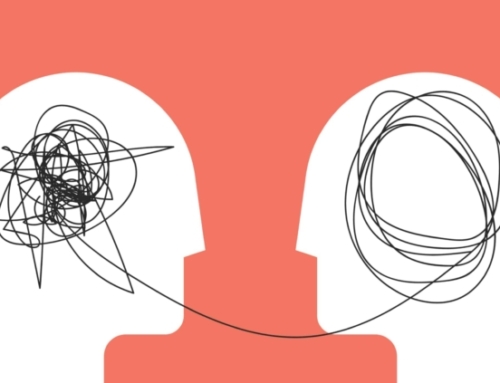Clinician openness towards patients is a multivalent concept with various meanings. From my work with psychiatry residents and other mental health professionals, I learned that the common, ‘default’ meaning of openness when it comes to patient care is ‘the sharing of personal information with the patient.’ This is certainly one meaning, but, as I’ll set out to show here, not the foundational one nor, often, a necessary or even wise one to undertake with a patient. I start with an exploration of the notion of openness and then use it to consider three ways of thinking about and acting on ‘clinical openness’ in our clinical work.
Open originates from the root upo, “up from under, over.” Its meanings are: plain, unobstructed, unimpeded, accessible, generous, genuine, and frank.
A philosopher I read, Ivo De Gennaro, describes openness thusly:
“[A] house is ‘open’ not because all doors are unlocked, but thanks to a capacity for welcoming and giving hospitality; … a mind is ‘open’ not because it absorbs whatever is presented to it, but thanks to the fact that it can critically assess and thus admit, or reject, new ideas or viewpoints; the relationship between two human beings is characterized by ‘openness’ not because everything is laid bare, but when both of them grant each other the unsaid and unknown source of their freedom, in such a way that whatever has to be said in order to preserve this freedom, can be said; the sky is ‘open’ (clear, spacious) in that it soothes the soul that, in turn, is open to it; a face or an expression is ‘open,’ that is, friendly and such as to inspire confidence and trust, in that, in some way or another, it shows the unobstructed but invisible source of the humanity of man, etc.” *
Let me now present three ways of thinking about openness in clinical situations.
Openness as Sharing Personal Information
Not infrequently, clinicians, in their desire to establish therapeutic engagement and rapport, resort to sharing personal information with patients. This is a therapeutic technique that can, at times, be used with great positive effect. A patient who has been disengaged from treatment, not adherent to prescribed treatment nor even to treatment recommendations, may gain a different perspective on the relationship with the clinician and the wisdom of the clinician’s treatment recommendations. This type of personal information may include the fact that the clinician also suffered from depression or anxiety or an eating disorder, or that the clinician also was skeptical of listening to their mental health clinician.
This type of sharing is undertaken in good faith: the clinician is striving to connect with the patient, to have the patient take their well-supported recommendations to heart and to give them a ‘good try.’ This approach, however, has downsides. One common one is that the patient becomes curious and begins asking for more and more personal information of the clinician. The clinician is caught in a bind, often feeling increasingly uncomfortable revealing personal information – at times highly intimate information – but not knowing how to pivot away from such disclosures. After all, it was the clinician who opened the path to personal sharing. A less common but equally countertherapeutic outcome is the clinician who does not experience misgivings and continues to share their personal information. This can devolve into two ‘lost souls’ comforting each other. This is a breach of professional conduct. No clinician is there to work out their own problems at the expense of the patient. Some patients already have a history of parentified relationships in which they inevitably are left saving the other party. Now, the treatment relationship just recapitulates all those other relationships that did not serve the patient well. Additionally, these types of oversharing relationships are susceptible to further and worse breaches of the professional relationship.
Many clinicians succumb to personal sharing despite their initial discomfort with such behavior because they did not learn other methods, ones both more effective and much less prone to countertherapeutic devolution, to establish a well-grounded therapeutic relationship with patients. Below I raise two alternate ways of practicing ‘openness’ with patients without sharing personal historical information.
Openness as Reflecting on the Here-and-Now Relationship
One technique I learned that can lead to an open, strong, and robust relationship with the patient is to be open in the here-and-now interactions with the patient. This is a technique native to transference-focused psychotherapy, existential psychotherapy, and dialectical behavioral therapy.
In this approach the clinician establishes from the first interaction with the patient the fact that the relationship between clinician and patient is fair game for looking at and talking about. In fact, not only is it tolerated, it is encouraged because the relationship is seen as itself being a therapeutic agent, as powerful – or more powerful – than any medication or neuromodulatory treatment that may be offered.
The reason the relationship itself is so therapeutically effective, independently from any other treatments deployed, is because many of our patients do not currently have or have never had a mature, open, trusting relationship; one not based on instrumental advantage, intimidation, or ending in betrayal. Thus, the relationship with the clinician can be something that is currently lacking, never before attained, and/or never modeled or learned from the patient’s family of origin or in their adult relationships.
The simplest and most neutral technique in attending to the relationship is to ‘check in.’ In this approach, the clinician asks simply, “How are we doing?” Notice the ‘we’ rather than the alternative ‘you.’ This is done at the first session and repeated as relevant at subsequent sessions.
Other techniques in this family of ‘attending to the here and now’ are to focus more directly on the patient. This includes the core psychodynamic interventions of clarifying, interpreting, and confronting. Interpreting the meanings and origins of a patient’s emotional and behavioral reactions may seem neutral but it is not: the patient may feel – rightly – ‘psychoanalyzed,’ surveilled, and judged. If these psychodynamic techniques are used, two additional things should happen. First, the patient needs to be educated on what they signed up for in this type of therapy, that is, know that interpretations of their behavior and other reactions are part of the treatment. This is especially important if the patient did not specifically self-refer for ‘psychodynamic therapy.’ The second thing needed is, following a session of interpretation and confrontation, the clinician returning to the ‘check-in’ question: “How are we doing now?” If the patient is not forthcoming – often the case, after all, what can one say after being ‘psychoanalyzed’ over the preceding 45 minutes – the clinician can offer something like, “I’m not sure hearing everything I had to say was helpful. Do you think I was too hard on you? Or I got it wrong? How do you think I can be different in our interactions?”
Openness as Welcoming and Anticipating a Trusting Relationship
So, to now connect with Ivo De Gennaro’s poetic descriptions of openness: notice and imagine how regularly checking-in with the patient on the state of the here-and-now relationship, making clear that it is the relationship that is the most important thing between the clinician and patient rather than any particular thing said or done within that relationship, is the foundation of therapeutic engagement. The patient should feel heard, feel that their views are valuable – in fact, the most valuable –, trust the clinician to always act in their interests, trust the clinician to not being afraid of saying what needs to be said, irrespective of how hard it might be to say that or to hear that.
Notice also how attending to and respecting the relationship leads to a strong relationship and to therapeutic engagement. Notice how the clinician sharing personal information almost seems besides the point. The core of the relationship is the sharing of what is happening in the present moment and not about what may or may not have occurred in the clinician’s past.
A last thought about clinician comportment. Another ‘mistake’ clinicians make in their efforts to build therapeutic engagement is to act like a cheerleader to the patient. An example is when a patient matter-of-factly states he’s been sober for 90 days. The cheerleading clinician then squeals with delight about how awesome that is. First, this type of communication often comes off as cringy, not really clued into the challenges of keeping sober, and it can set up the clinical relationship for failure. After all the squealing, how can a patient feel comfortable admitting to returning to drinking, as will often happen? Instead, if it is the relationship that is seen as paramount, one based on openness and trust, no overly enthusiastic emoting is called for. Rather, it is the relationship that will see the clinician and patient work together through thick and thin. (My default rebuttal to learning the patient is 90-days sober would be more like this: “So, any slips during those 90 days?” Then, “I’m glad to hear about the 90 days. I am eager to learn what you’ve learned from these 3 months of sobriety; both what’s kept you going and what’s been hardest. And what can lead to relapse. There’s a lot for us to talk about and I look forward to working with you on all this.”)
Share your thoughts by replying to this email.
Take care,
Dr. Jack
Language Brief
“For there to be betrayal, there would have to have been trust first.” ― Suzanne Collins
“One does not become enlightened by imagining figures of light, but by making the darkness conscious. The latter procedure, however, is disagreeable and therefore not popular.” ― C.G. Jung
“If we do not trust one another, we are already defeated.” — Alison Croggon
“What labels me, negates me.” — Soren Kierkegaard
“Trust is the glue of life. It’s the most essential ingredient in effective communication. It’s the foundational principle that holds all relationships.” ― Stephen R. Covey
Resources
Reference: De Gennaro, Ivo. The weirdness of being: Heidegger’s unheard answer to the Seinsfrage. Routledge, 2014. (page 157, footnote 24)







Leave A Comment